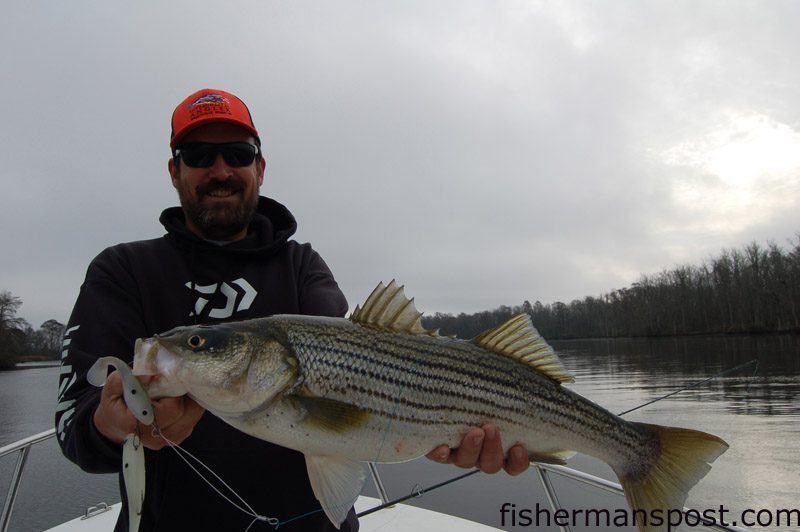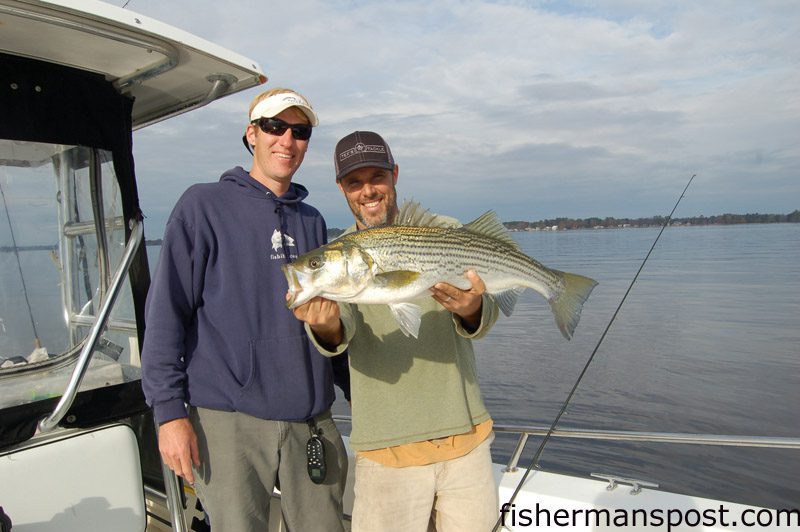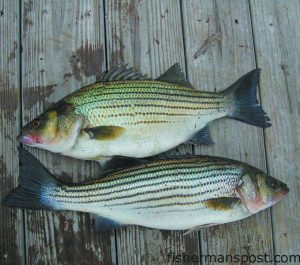Guide Time – Butterballs And ‘Bama Rigs

The author with a healthy Pamlico River striped bass that couldn’t resist a trio of Yee Ha swimbaits rigged on JP jigs on a custom wire rig created by Capt. Mitchell Blake of FishIBX.com.
“See how these marks are short and fat?” Capt. Mitchell Blake asked as his 23’ C-Hawk center console glided up the Pamlico River past the Washington, NC, waterfront. “Those are striper marks—butterballs.”
Sure enough, large clusters of the fat blobs were visible just above the bottom in 18’ of water.
“That’s a gar,” he continued, a few yards further upriver. “See how it’s long and skinny? I’ve got this machine locked in so when these fish move I can go find them.”
The fat/skinny/fat marks continued alternating as we idled between a colorful collection of live-aboard sailboats anchored up off the river channel and moored at the town’s docks.
Mitch, whose charter company FishIBX.com covers the entirety of North Carolina’s Inner Banks, had invited Fisherman’s Post Publisher Gary Hurley and I on an early December striper excursion, and we were more than happy to accept, making an early drive up from Wilmington to meet him at a little boat ramp on his property on a creek leading to Chocowinity Bay. We’d been accompanied by flocks of several species of ducks fading in and out of the morning mist on the brief, but brisk run out of the bay and upriver to Washington before Blake began the high-tech hunt for our quarry.
The captain not only connects clients with striped bass, speckled trout, red drum, and more but combines his experience in environmental monitoring with his time on the water as the lower Neuse Riverkeeper, a job that keeps him keenly aware of fish behavior and movements not only on the Neuse but the other mainland river and estuary systems opposite the Outer Banks.
A sharp cold snap over Thanksgiving had thrown off a hot and heavy bite further down in the river, and Mitch was in search mode, eyes on both the standard depth sounder and a side imaging Humminbird unit that lets him examine a 100’ swath of water and bottom instead of just what’s directly under the boat.
“A lot of people think these fish move down towards the sound when you get a big drop,” Mitch explained as we continued motoring upcurrent, “but I’ve found a lot of times they move up to almost solid fresh water, like a spawning run. I think they go upstream in the flow because it’s almost like CPR—they get oxygen from the current and don’t want to move a lot.”
Though we’d marked some fish around Washington, Mitch continued upriver a short distance north of town to some spots that he’d caught fish since the cold snap.
“We’re actually in a four-day upward stretch now,” he added after putting the C-Hawk on plane for a short distance. “So some of the fish are moving up and some are moving down, and I want to find a good ball of them.”
When he finally found a solid stretch of stripers on the side scan north of the Highway 17 bypass bridge, Mitch handed Gary and I each a stout Temple Fork Outfitters spinning rod bearing a custom rig of his own creation.
The captain makes wire frames with 3-5 arms for a multi-lure presentation, a take on the Alabama rig popular in freshwater bass circles and a miniature version of the umbrella rigs many anglers troll for stripers in other regions.
Each arm of the frames bore a snap swivel and a hand-poured soft plastic swimbait from Winston-Salem’s Yee Ha Baits, an impressive offering that swam with a thump visible in even the heavy outfit’s rodtips on the retrieve.
“I make these myself for a couple reasons,” Mitch elaborated when I asked him about the rigs. “I can afford to have customers throw and lose them, and I use a lighter welding wire that isn’t as stiff so the whole school of baits swims together in rhythm.”
Despite the savings realized from making the rigs himself, 3-4 of the custom swimbaits is still a substantial cost, and casting them in the rock and tree-choked structure where the Pamlico River stripers feed can be an expensive proposition, so Mitch coaches anglers’ retrieves in order to minimize hang-ups.
“The bottom comes up to 5’ from 14’ here,” he said as he eased us towards a long point at the mouth of a nearby creek. “The top is covered in trees, so go ahead and be cranking on it when it hits the water. They use the drop as an ambush point and usually hit right as it crosses the ridge.”
A dozen casts in, our swimbaits had yet to meet an ambush, and Mitch quickly decided to try another nearby spot.
“They were here yesterday, though,” he said after we’d hung up the rods. “I think we’re going to come back a little later.”
Mitch throttled the C-Hawk up for a brief run further towards fully fresh water, and was soon dropping his remote control trolling motor back into the water off a custom mount he fabricated for his engine bracket.
Commenting on the somewhat unusual setup of the Minnkota I-Pilot, I quickly realized that the 23’ center console itself was a bit different than the bass and jon boats we’d seen also hunting striped bass that morning. Mitch runs a 21’ Southern Skimmer for much of his charter season, but explained he shifts to the big boat as soon as the weather turns cold.
“I used to fish the Skimmer in the winter,” he said, “but that was tough. I had some customers get off the boat and tell me it was the coldest they’ve ever been. With the curtains on this one, we can run and keep out of the wind—it’s a whole lot better.”
Without the need to chase fish in super-shallow water in the area, the big boat makes plenty of sense in the cooler months, and it offers a tremendous amount of casting room at the same time.
“Alright gang,” Mitch said after using the motor to position us. “Let’s cast to the right of that point over there, let them sink down, and crank slow along the bottom.”
Casting a chartreuse tandem grub rig himself after we’d tossed our swimbaits, Mitch quickly proved he knew what he was talking about when it came to the sounder.
He’d twitched the lures twice when I saw his rod tip snap up and bend back towards the water, bucking as a fish realized it was hooked and began to protest.

Capt. Mitchell Blake, of FishIBX.com, and Fisherman’s Post Publisher Gary Hurley with a striped bass that fell for Yee Ha swimbaits on a custom umbrella rig made by Blake.
Spunky, but lacking a bit in the stamina department, the fish soon relented to the pressure of Mitch’s light TFO spinner, and he was quickly sliding a net under our first striper of the day. Though it was a bit shy of the 18” minimum size for stripers in the Pamlico basin, everybody aboard was pleased to have landed one of our target species in the boat. The bright jig protruding from the bass’s oversized mouth made for a fine photo opportunity, and Mitch soon eased the feisty little fish back into the Pamlico’s tannin-stained water, and its black-striped flanks disappeared back into the river with a quick flick of the tail.
“I’m going to ease back over toward that point and hold us there,” Mitch said punching a button on the trolling motor’s remote to engage the unit’s GPS-based anchor.
My rod tip was thumping rhythmically with the swimbaits two casts later when it was interrupted with a jarring bite almost beneath the boat, ripping drag off the 4000 spinner before I could even get the tip up for a hookset.
“I think this one’s a little bigger,” I grunted as I raised the rod and the fish bulldogged a few more yards of line off the reel.
It was definitely showing a bit more mettle than the fish we’d just released, and soon boiled the surface to confirm the hypothesis. The silver-white sides disappeared just as quickly as they’d popped up, with the fish tearing off line again in a short burst back to the river bottom 20’ below. Making no long runs, but matching my gains with dogged resistance and more drag song, it took a few more minutes to pressure the striper to the surface, where Mitch’s landing net laid waiting.
Indeed, this fish was larger, measuring just a tad shy of the 27” mark, and it, too, begrudgingly modeled for the camera before I eased it back in the water.
“Just move him around in the current and he’ll take right off,” the captain instructed as I leaned over the gunnel.
I held the striper’s mouth open into the current and after taking advantage of a bit of Pamlico River CPR, the fish soon let me know it was ready to rejoin its schoolmates, breaking my grasp on its lower lip with a quick thrash.
The two quick fish definitely raised the boat’s collective pulse, but a half-dozen casts later, a snagged gar was the only further excitement, and Mitch decided it was time for a move.
“Let’s go check that first spot back out, gang,” he said after sending the gar on its way.
The trip took less than 10 minutes, and we were soon again tossing lures to the submerged timber ledge where we’d started the day.
Gary didn’t take long to add his own striper to the boat, hooking up on his second cast while my umbrella rig found a home in one of the underwater treetops (which didn’t budge despite my vigorous hookset). I was able to shake the rig free just in time to snap some shots of Gary’s fish, another just under keeper size.
He’d scarcely had time to make another cast before I caught another hookset out of the corner of my eye, and Gary was on again, this time losing a little line as the fish attempted to find the sunken cover. His rod tip up, the publisher kept the fish out of the trees and had soon worked it to open water, where the fish protested a bit more before relenting to the upward strain and appearing in the stained water.
The fish met the rubber mesh of the landing net moments later, and Mitch swung it aboard. A quick check of the measuring tape proved this to be our first keeper, and the 20” fish was soon finning in the C-Hawk’s leaning post livewell.
Two fish in two casts proved tough to ignore, so I splashed my rig down in the same vicinity a few times and got a sharp bite just on the edge of the drop-off. Setting the hook, I felt a bit of a headshake, but the tackle soon overpowered whatever was on the hook. The slight resistance proved to be a small largemouth bass that couldn’t ignore the swimbaits itself, a cool addition to our catch and a testament that the stripers were indeed in some rather fresh water.
Again, we made a few more casts without action, and Mitch was quick to pull the plug on the spot, opting to head downriver to see if the warming trend had sent some fish headed toward a more saline environment.
Casting to another submerged stand of stumps and timber near the 17 bypass bridge, Mitch continued his running commentary that keeps anglers in the fish and out of the wood.
“The stern’s sitting in 14’ right now, gang,” he said, positioning the boat just off another drop-off. “And it’s 8’ and covered in stumps right in front of us. Cast off the bow and towards the bridge but keep them moving good until you get back close to the boat.”
Both Gary and I still managed to find the trees on occasion, but using the trolling motor to get on the opposite sides of the obstruction and occasionally breaking out a telescoping lure retriever, Mitch kept us from breaking off many of the rigs I thought were sure goners.
We hopscotched downriver, making a dozen or so casts at a variety of spots before a quick pit stop at Bill’s Hot Dogs, a Washington institution, for an amusing and tasty lunch that could be the topic of another story itself.
After packing in a few of the deep-fried, red dogs, we resumed our trek south.
“Cast toward that rockpile,” Mitch instructed as we pulled up to another spot on the opposite side of the river. “It comes all the way out to where we’re sitting, and you want to cast to the sides of it and bring them back pretty slow.”

The hybrid striped bass above (a cross between a striper and a white bass) has a more thickly-built body and slight color variations over the purebred striper below.
Gary struck again on his second cast, landing another keeper with substantially more girth than the one in the livewell.
“See how he’s thicker? That’s a hybrid striper,” Mitch explained, laying the two fish next to each other. The difference was easy to see, as the latest addition definitely had a width advantage over the first, along with broken stripes instead of the smooth lines on the smaller fish.
We’d made it nearly back to Chocowinity Bay when Mitch again dropped the trolling motor in water a distinctly different color than that near Washington and north.
“Look at this funky water,” Mitch said. “It’s almost orange.”
Darker boils after he put the motor in gear revealed the rusty water to be only a surface condition, and Mitch again offered some insight into the new spot.
“This is a huge area of structure,” he said. “It’s 8 foot deep. You can cast 360 degrees and still be on it.”
One of my first casts resulted in a hard strike but no hookup, and Mitch soon had the same result.
I’d just popped another solid hookset into an unseen obstacle when I heard a simultaneous splash and a shout from the bow.
“Whoa!” Gary exclaimed as another big striper broke water with a mouth full of swimbaits just off the C-Hawk’s port gunnel and proceeded to put some distance between itself and the vessel.
The stout rods are slightly overkill for the smaller fish that fall for the umbrella rigs, but this fish proved a fine match for the tackle, bulldogging around in the dirty water and leaving the fight’s outcome in doubt for a few moments.
A center console trolling nearby gawked at the action while Hurley grappled with the fish.
“They just don’t catch these big fish trolling,” Mitch explained. “They catch the small ones, but you catch those casting and get shots at the big ones. It’s a lot more fun, too, isn’t it?”
Neither of us could disagree, particularly Gary, who was cackling with laughter as the fish took him up and down the port gunnel.
A few more minutes passed before the fish finally tired enough for the newspaperman to make some progress, and after a bit of drama boatside, another fat fish lay on deck, with Gary still laughing in delight. This one was near 28” and destined for the livewell, after a bit more involved photo session than the smaller stripers partook in.
Several fish had attacked baits near the boat during the bite, and our subsequent casts produced several more bites, hookups, and another keeper fish for the livewell to fill out a two-man limit for Gary and me.
With stripers on the menu in the Blake household on a weekly basis, Mitch didn’t want any for the pan, so we decided to call it a day after checking on another spot close to Mitch’s property.
The spot couldn’t be a better jumping-off point for anglers looking to fish the Pamlico River, and the secluded piece of property backs up to a large marsh and woods system where Mitch regularly sees turkeys, deer, and a wide variety of other wildlife. He’s building a home on a small bluff overlooking the creek, and plans are in the works for a barn/workshop that will also feature some accommodations so visiting anglers can spend the night just steps away from where they’ll board the boat. Camping directly on the water is another possibility.
Striped bass are the FishIBX.com gameplan all winter, both in the Pamlico and the western Albemarle Sound, a remote area where both artificial and fly casters can experience some incredible action in the dead of winter. Speckled trout, puppy drum, flounder, and giant red drum and tarpon are in his crosshairs in the warmer months.
Learn more about Capt. Mitchell Blake and his business at www.fishibx.com or give him a call to talk about your own trip at (252) 495-1803.





